Oldsmobile Alero 2003 Owner's Manuals
Manufacturer: OLDSMOBILE, Model Year: 2003, Model line: Alero, Model: Oldsmobile Alero 2003Pages: 354, PDF Size: 16.74 MB
Page 281 of 354
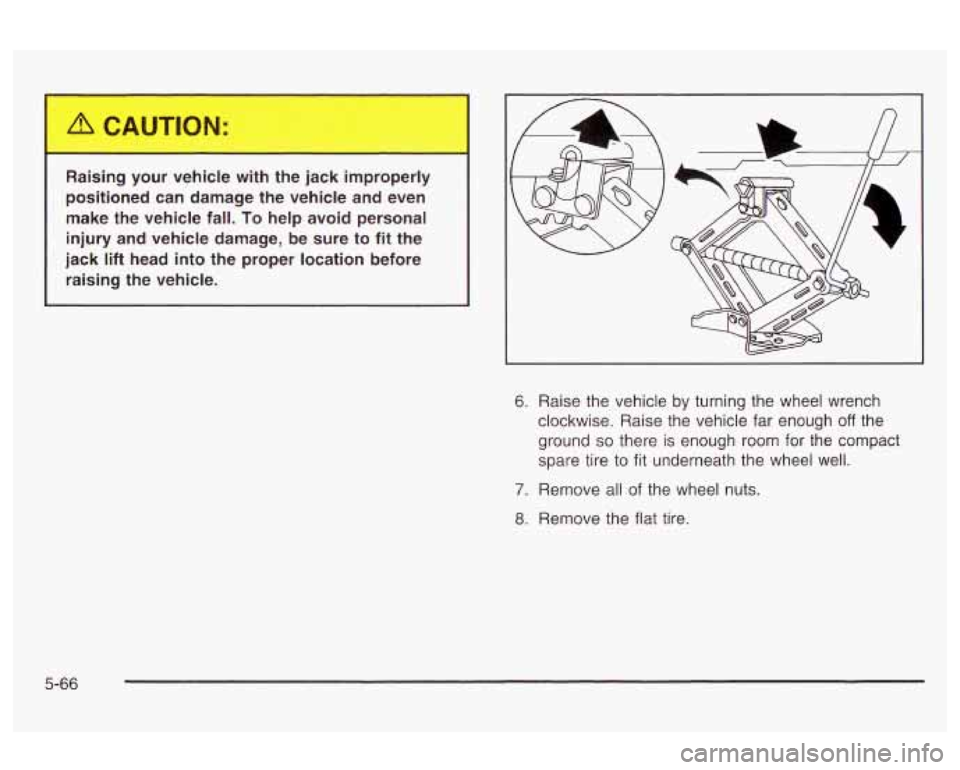
. Asing your vehic- ..____ __._ jal--- impropc -r
positioned can damage the vehicle and even
make the vehicle fall. To help avoid personal
injury and vehicle damage, be sure
to fit the
jack lift head into the proper location before
raising the vehicle.
6. Raise the vehicle by turning the wheel wrench
clockwise. Raise the vehicle far enough
off the
ground
so there is enough room for the compact
spare tire to fit underneath the wheel well.
7. Remove all of the wheel nuts.
8. Remove the flat tire.
5-66
Page 282 of 354
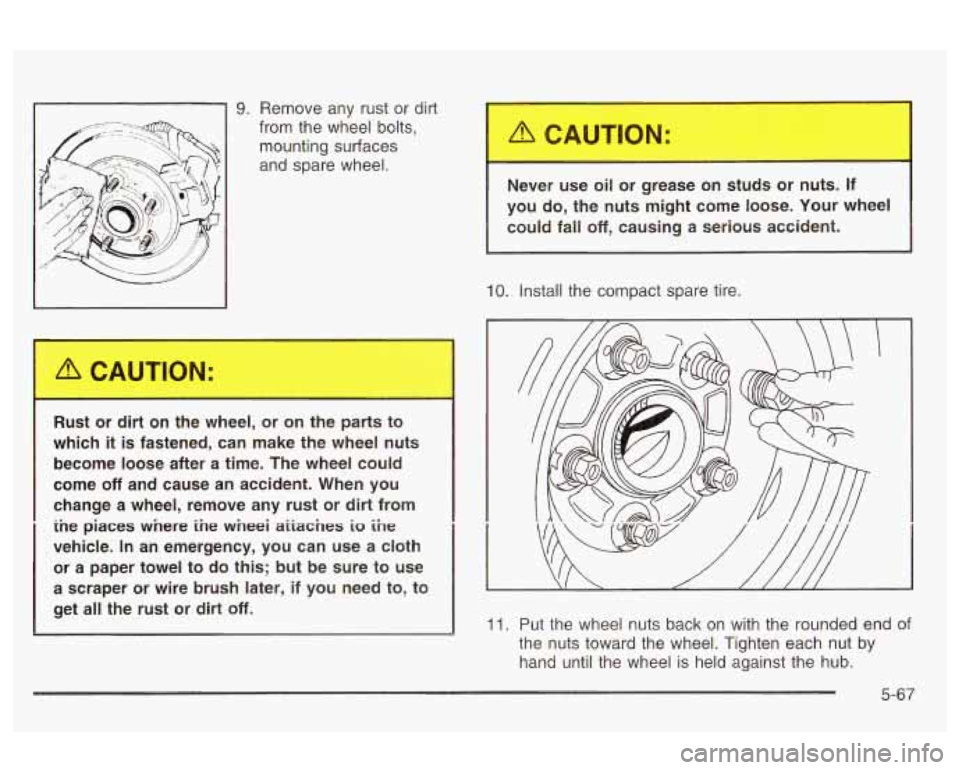
9. Remove any rust or dirt
from the wheel bolts,
mounting surfaces
and spare wheel.
R---t OL Art on the wheel, or on the parts to
which
it is fastened, can make the wheel nuts
become loose after a time. The wheel could
come
off and cause an accident. When you
change a wheel, remove any rust or dirt from
ine piaces wnere ine wneei aiiaches io ihe
vehicle. In an emergency, you can use a cloth
or a paper towel to do
this; but be sure to use
a scraper or wire brush later, if you need to, to
get all the rust or dirt
off.
Never use c or grease on studs or nl If
you do, the nuts might come loose. Your wheel
could fall
off, causing a serious accident.
10. Install the compact spare tire.
11. Put the wheel nuts back on with the rounded end of
the nuts toward the wheel. Tighten each nut by
hand until the wheel is held against the hub.
5-67
Page 283 of 354

12. Lower the vehicle by turning the wheel wrench
counterclockwise. Lower the jack completely.
13. Tighten the wheel nuts
firmly
in a crisscross
sequence,
as shown. Incorrect wheel nuts or improperly tightened
wheel nuts can cause the wheel to come loose
and even come
off. This could lead to an
accident. Be sure to use the correct wheel
nuts. If you have to replace them, be sure to
get new GM original equipment wheel nuts.
Stop somewhere as soon as you can and have
the nuts tightened with a torque wrench to the proper torque specification. See ”Capacities
and Specifications’’ in the Index for wheel nut
torque specification.
Notice: Improperly tightened wheel nuts can lead
to brake pulsation and rotor damage.
To avoid
expensive brake repairs, evenly tighten the wheel
nuts in the proper sequence and to the proper
torque specification. See “Capacities and
Specifications”
in the index for the wheel nut torque
specification.
Notice: Wheel covers won’t fit on your compact
spare. If you try
to put a wheel cover on your
compact spare, you could damage the cover or the
spare.
5-68
Page 284 of 354
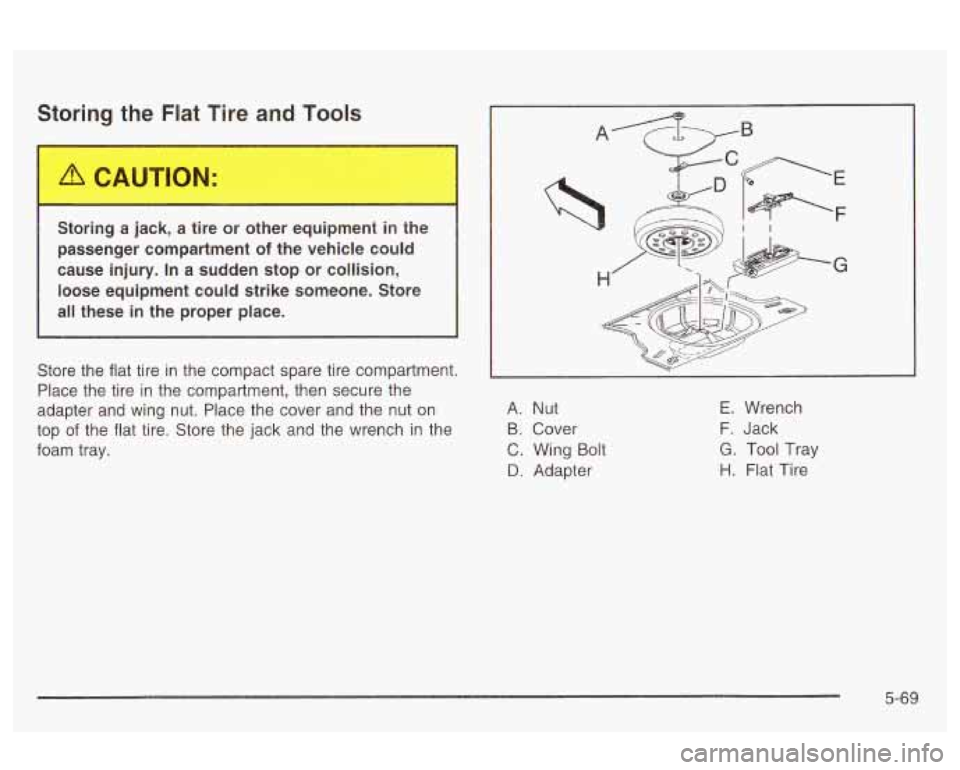
Storing the Flat Tire and Tools
Storing a jack, a tire or other equipment in 1
passenger compartment of the vehicle could
cause injury. In a sudden stop or collision,
loose equipment could strike someone. Store
all these in the proper place.
Store the flat tire in the compact spare tire compartment.
Place the tire in the compartment, ther! secure the
adapter and wing nut. Place the cover and the nut on
top of the flat tire. Store the jack and the wrench in the
foam tray.
A L
F
G
A. Nut
B. Cover
C. Wing Bolt
D. Adapter
E. Wrench
F. Jack
G. Tool Tray
H. Flat Tire
5-69
Page 285 of 354
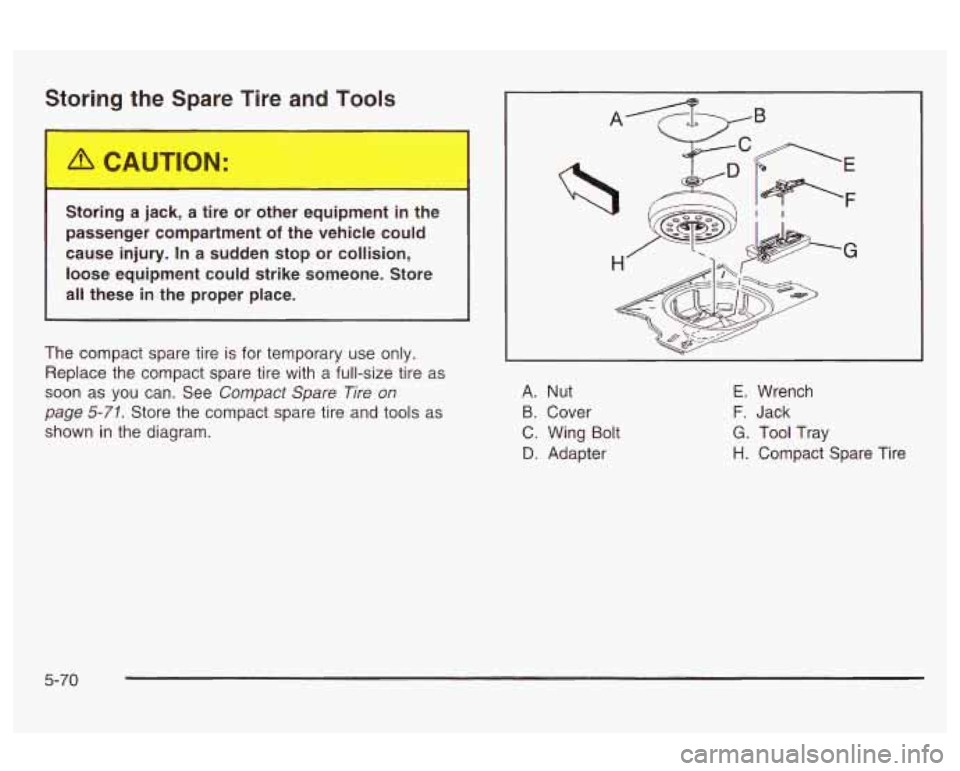
Storing the Spare Tire and Tools
StG..ng a jack, a tire or other equipment in the
passenger compartment
of the vehicle could
cause injury. In a sudden stop or collision,
loose equipment could strike someone. Store
all these in the proper place.
The compact spare tire is for temporary use
only.
Replace the compact spare tire with a full-size tire as
soon as
you can. See Compact Spare Tire on
page 5-71. Store the compact spare tire and tools as
shown in the diagram. A.
Nut
B. Cover
C. Wing Bolt
D. Adapter
E. Wrench
F. Jack
G. Tool Tray
H. Compact Spare Tire
5-70
Page 286 of 354
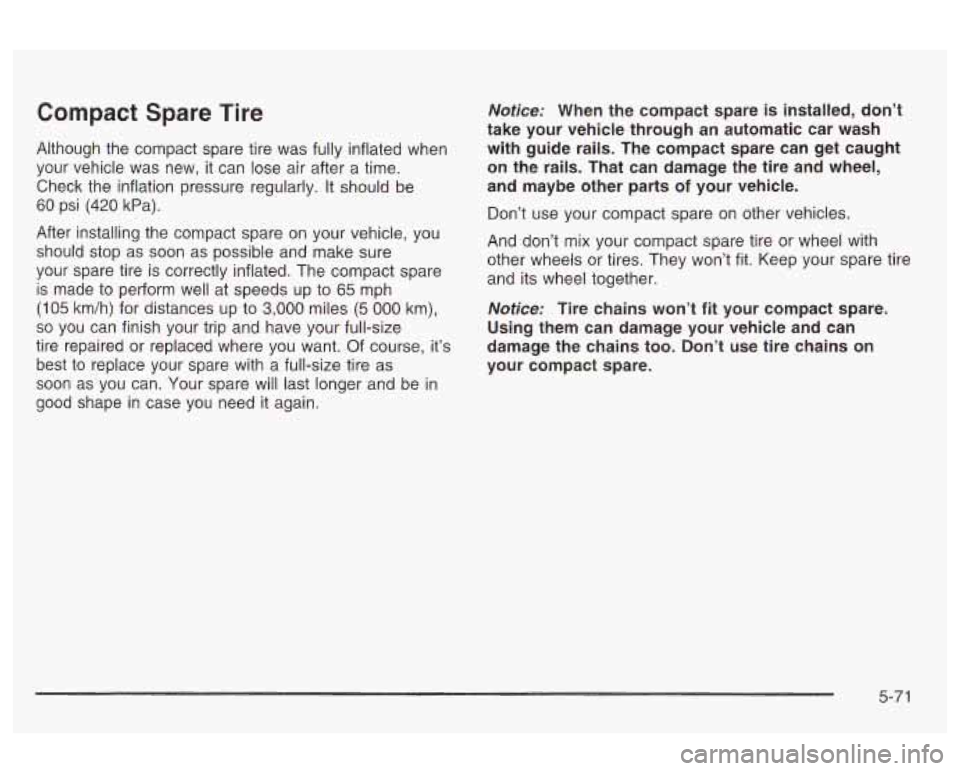
Compact Spare Tire
Although the compact spare tire was fully inflated when
your vehicle was new, it can lose air after a time.
Check the inflation pressure regularly.
It should be
60 psi (420 kPa).
After installing the compact spare on your vehicle, you
should
stop as soon as possible and make sure
your spare tire is correctly inflated. The compact spare
is made
to perform well at speeds up to 65 mph
(1 05 km/h) for distances up to 3,000 miles (5 000 km),
so you can finish your trip and have your full-size
tire repaired or replaced where you want. Of course, it’s
best to replace your spare with a full-size tire as
soon as you can. Your spare will
last longer and be in
good shape in case you need it again.
Nofice: When the compact spare is installed, don’t
take your vehicle through an automatic car wash
with guide rails. The compact spare can get caught
on the rails. That can damage the tire and wheel,
and maybe other parts
of your vehicle.
Don’t use your compact spare on other vehicles.
And don’t mix your compact spare tire or wheel with
other wheels or tires. They won’t fit. Keep your spare tire
and its wheel together.
Notice: Tire chains won’t fit your compact spare.
Using them can damage your vehicle and can
damage the chains too. Don’t use tire chains on
your compact spare.
5-7 1
Page 287 of 354
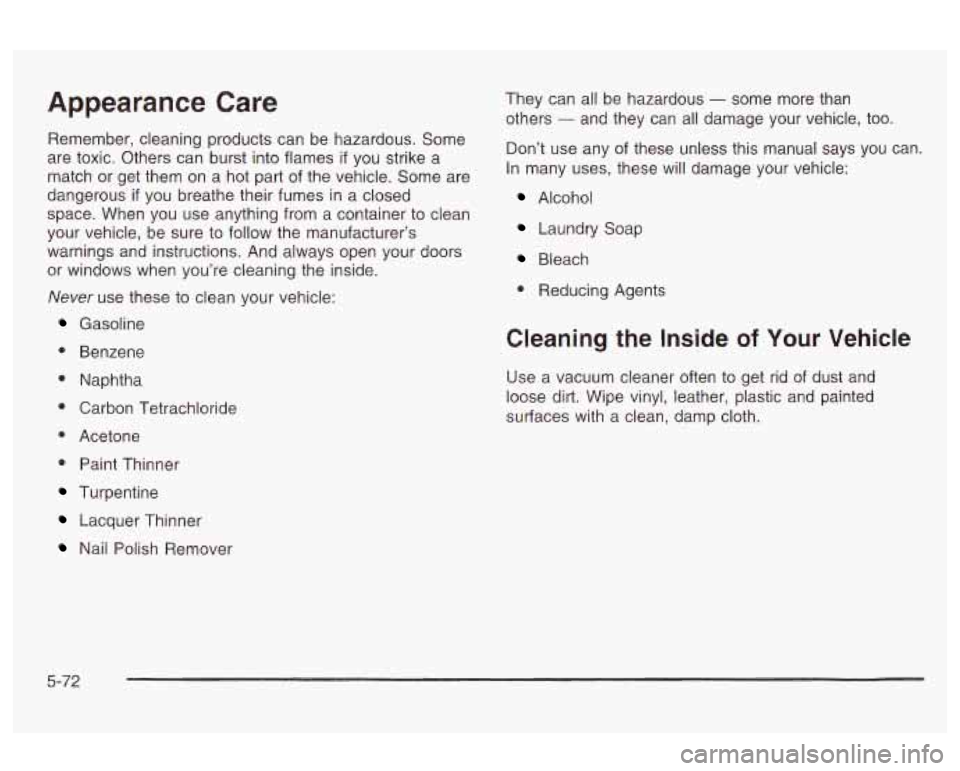
Appearance Care
Remember, cleaning products can be hazardous. Some
are toxic. Others can burst into flames
if you strike a
match or get them on a hot part
of the vehicle. Some are
dangerous
if you breathe their fumes in a closed
space. When you use anything from a container to clean
your vehicle, be sure to follow the manufacturer’s
warnings and instructions. And always open your doors
or windows when you’re cleaning the inside.
Never use these to clean your vehicle:
Gasoline
0 Benzene
0 Naphtha
0 Carbon Tetrachloride
Acetone Paint Thinner
Turpentine
Lacquer Thinner They can
all be hazardous
- some more than
others
- and they can all damage your vehicle, too.
Don’t use any of these unless this manual
says you can.
In many uses, these will damage your vehicle:
Alcohol
Laundry Soap
Bleach
0 Reducing Agents
Cleaning the Inside of Your Vehicle
Use a vacuum cleaner often to get rid of dust and
loose dirt. Wipe vinyl, leather, plastic and painted
surfaces with a clean, damp cloth.
Nail Polish Remover
5-72
Page 288 of 354
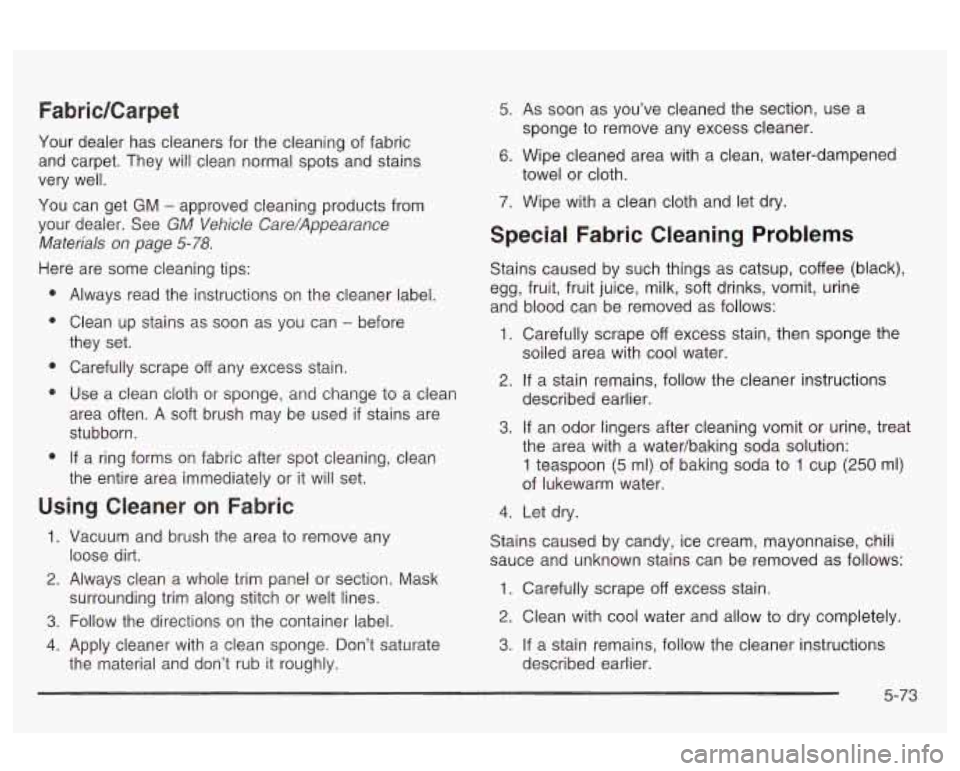
FabricKarpet
Your dealer has cleaners for the cleaning of fabric
and carpet. They will clean normal spots and stains
very well.
You can get GM
- approved cleaning products from
your dealer. See
GM Vehicle Care/Appearance
Materials
on page 5-78.
Here are some cleaning tips:
a
a
-.
Always read the instructions on the cleaner label.
Clean up stains as soon as you can
- before
they set.
Carefully scrape
off any excess stain.
Use
a dean cioth or sponge, and change io a cieari
area often. A soft brush may be used if stains are
stubborn.
If a ring forms on fabric after spot cleaning, clean
the entire area immediately or it will set.
Using Cleaner on Fabric
1. Vacuum and brush the area to remove any
loose dirt.
2. Always clean a whole trim panel or section. Mask
surrounding trim along stitch or welt lines.
3. Follow the directions on the container label.
4. Apply cleaner with a clean sponge. Don’t saturate
the material and don’t rub it roughly.
5. As soon as you’ve cleaned the section, use a
6. Wipe cleaned area with a clean, water-dampened
7. Wipe with a clean cloth and let dry.
sponge
to remove any excess
cleaner.
towel or cloth.
Special Fabric Cleaning Problems
Stains caused by such things as catsup, coffee (black),
egg, fruit, fruit juice, milk, soft drinks, vomit, urine
and blood can be removed as follows:
1. Carefully scrape off excess stain, then sponge the
2. If a stain remains, follow the cleaner instructions
soiled
area with cool water.
described earlier.
3. If an odor lingers after cleaning vomit or urine, treat
the area with a watedbaking soda solution:
1 teaspoon (5 ml) of baking soda to 1 cup (250 ml)
of lukewarm water.
4. Let dry.
Stains caused by candy, ice cream, mayonnaise, chili
sauce and unknown stains can be removed as follows:
1. Carefully scrape off excess stain.
2. Clean with cool water and allow to dry completely.
3. If a stain remains, follow the cleaner instructions
described earlier.
5-73
Page 289 of 354
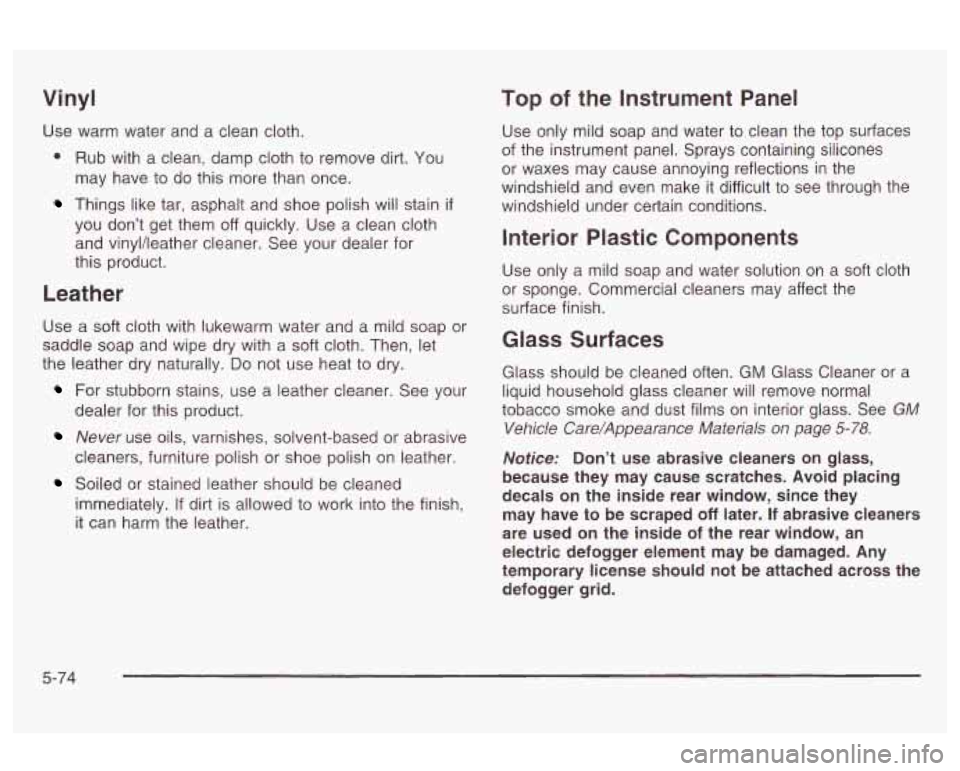
Vinyl
Use warm water and a clean cloth.
0 Rub with a clean, damp cloth to remove dirt. You
may have to do this more than once.
Things like tar, asphalt and shoe polish will stain if
you don’t get them off quickly. Use a clean cloth
and vinyl/leather cleaner. See your dealer for
this product.
Leather
Use a soft cloth with lukewarm water and a mild soap or
saddle soap and wipe dry with a soft cloth. Then, let
the leather dry naturally.
Do not use heat to dry.
For stubborn stains, use a leather cleaner. See your
dealer for this product.
Never use oils, varnishes, solvent-based or abrasive
cleaners, furniture polish or shoe polish on leather.
Soiled or stained leather should be cleaned
immediately. If dirt is allowed
to work into the finish,
it can harm the leather.
Top of the Instrument Panel
Use only mild soap and water to clean the top surfaces
of the instrument panel. Sprays containing silicones
or waxes may cause annoying reflections in the
windshield and even make it difficult to see through the
windshield under certain conditions.
Interior Plastic Components
Use only a mild soap and water solution on a soft cloth
or sponge. Commercial cleaners may affect the
surface finish.
Glass Surfaces
Glass should be cleaned often. GM Glass Cleaner or a
liquid household glass cleaner will remove normal
tobacco smoke and dust films on interior glass. See
GM
Vehicle Care/Appearance Materials on page
5-78.
Notice: Don’t use abrasive cleaners on glass,
because they may cause scratches. Avoid placing
decals on the inside rear window, since they
may have to be scraped
off later. If abrasive cleaners
are used on the inside
of the rear window, an
electric defogger element may be damaged. Any
temporary license should not be attached across the
defogger grid.
5-74
Page 290 of 354

Care of Safety Belts
Keep P+s clean and dry.
Do noi ,,,,ch or dye safety belts. If you do, it
may severely weaken them. In a crash, they
might not be able to provide adequate
protection. Clean safety belts only with mild
soap and lukewarm water.
Weatherstrips
Silicone grease on weatherstrips will make them last
longer, seal better, and not stick or squeak. Apply
silicone grease with a clean cloth at least every six
months. During very cold, damp weather more frequent
Fluids and Lubricants on page 6-15.
s.4~y,,”u..“. Qnnli,-Q+inn I I ml
I ,-J UY ha rqgIrpc!- spp Psfl !-J: .Rqc_nmrnended
Cleaning the Outside of
Your Vehicle
The paint finish on your vehicle provides beauty, depth
of color, gloss retention and durability.
Washing Your Vehicle
The best way to preserve your vehicle’s finish is to keep
it clean by washing it often with lukewarm or cold
water.
Don’t wash your vehicle in the direct rays
of the sun.
Use a car washing soap. Don’t use strong soaps
or chemical detergents. Be sure to rinse the vehicle
well, removing all soap residue completely.
You can get
GM-approved cleaning products from your dealer.
See
GM Vehicle Care/Appearance Materials on
page 5-78. Don’t use cleaning agents that are petroleum
based, or that contain acid or abrasives. All cleaning
agents should be flushed promptly and not allowed
to dry on the surface, or they could stain. Dry the finish
with a soft, clean chamois or an all-cotton towel to
avoid surface scratches and water spotting.
High pressure car washes may cause water to enter
your vehicle.
5-75